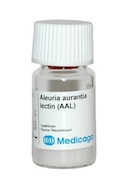** for pack size 100mg, 1 g or more, please contact us to inquire about pricing

Features
- Ultrapure quality
- Sugar specificity: fucose and terminal fucose residues on complex oligosaccharides and glycoconjugates
- Binding affinity for fucose in all binding positions �(α1-2, α1-3, α1-4 and α1-6)
- Higher affinity towards fucosylated oligosaccharides than native AaL
- Not blood group specific
Product description
Recombinant Aleuria aurantia lectin is produced in E.coli and has an amino acid sequence identical to native Aleuria aurantia lectin.
AAL is a dimeric lectin with two identical subunits of approximately 36
kDa. Each subunit has five carbohydrate-binding sites (1). The lectin
recognizes and binds specifically to fucose and terminal fucose residues
on complex oligo saccharides and glycoconjugates. rAAL has binding
affinity for fucose in all binding positions (α1-2, α1-3, α1-4
and α1-6) and in contrast to AAL purified from natural sources, rAAL is
not contaminated with free fucose yielding higher affinity towards
fucosylated oligosaccharides than native AAL (2).
Recombinant AAL hemagglutinates
erythrocytes irrespective of blood type (A, B and 0) at the same titers
as AAL isolated from natural sources.
AAL has been widely used for analysis
and preparation of oligosaccharides and glycoproteins (3). Diagnostic
applications include analysis of disease-associated glycosylation on
plasma proteins (4). Furthermore, rAAL can be immobilized and used for
affinity chromatography (5).
Applications
- Studies of glycoproteins and glycolipids
- Purification of membrane proteins
- Affinity chromatography
- Agglutination studies
Directions for use
The lectin may be reconstituted with 10 mM HEPES, 0.15 M NaCl, pH 7.5, 0.08 % sodium azide, 0.1 mM Ca , 0.01 mM Mn .
Spin the vial gently until full dissolution. Aggregation is thought to
occur in the presence of high concentrations of 2-mercaptoethanol.
Shipping and storage
The product is shipped at -20°C however
for over-the-day transport it may be shipped at ambient temperature. The
lyophilized powder is stable for more than three years from production
date when stored below -20°C. After reconstitution with HEPES buffer,
the solution may be stored frozen in working aliquots for up to 12
months.

References
(1) Wimmerova M, Mitchell E, Sanchez JF, Gautier C,
Imberty A. Crystal structure of fungal lectin: six-bladed beta-propeller
fold and novel fucose recognition mode for Aleuria aurantia lectin. J
Biol Chem. 2003; 278:27059-67.
(2) Olausson J, Tibell L, Jonsson BH, Påhlsson P.
Detection of a high affinity binding site in recombinant Aleuria
aurantia lectin.Glycoconj J. 2008; 25:753-62.
(3) Yazawa S, Kochibe N, Asao T. A simple procedure
for isolation of tumor-associated antigens by affinity chromatography
using fucose-specific Aleuria aurantia lectin. Immunol Invest. 1990;
19:319-27.
(4) Hashimoto S, Asao T, Takahashi J, Yagihashi Y,
Nishimura T, Saniabadi AR, Poland DC, van Dijk W, Kuwano H, Kochibe N,
Yazawa S. alpha1-acid glycoprotein fucosylation as a marker of carcinoma
progression and prognosis. Cancer. 2004; 101:2825-36.
(5) Bergström M, Aström E, Påhlsson P, Ohlson S.
Elucidating the selectivity of recombinant forms of Aleuria aurantia
lectin using weak affinity chromatography. J Chromatogr B Analyt
Technol Biomed Life Sci. 2011 [Epub ahead of print]
MSDS:
 MSDS (AAL)
MSDS (AAL)
If you cannot find the answer to your problem then please contact us or telephone +44 (0)1954 210 200